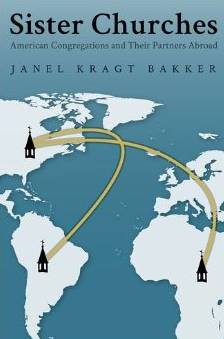
Religioscope – You write that these partnerships between churches are becoming more common but do you know how prevalent they are and which denominations they represent?
Bakker – Most denominations don’t keep records of this; they don’t have oversight [of sister churches]. Many congregations forge these partnerships on their own. Catholics keep the best records. My guess is that about 20 percent of Catholics and mainline Protestants have these partnerships; for evangelicals it’s a little lower-about 10 percent.
Religioscope – According to your book, these partnerships, especially for mainline Protestants and Catholics, developed during a period of re-thinking and changes in missions.
Bakker – I think a bunch of factors coalesced. There was the maturation of Southern Christianity; the idea that the church was centered in Europe was no longer true, if it was ever true. The churches were awakening to the problems of colonialism in missions and how it was tied to empire building. There was a new paradigm away from the sending model of missions. Just the new technology made maintaining long-term partnerships possible. Southern immigration also made it possible. Immigrants were central to generating interest and [congregations] being able to capitalize on their relationships in Africa and the Americas.
Religioscope – The practice of establishing sister churches spread to evangelical churches; is there much of a difference in their partnership from other Christian?
Bakker – There’s not really much of a differences reflected in whether they are conservative or liberal churches. Most of these churches are related in that they have access to the global world. Liberal churches can be paternalistic and conservative churches can be very global. What matters is how relational they are. But these churches do engage in different kinds of projects. Evangelical partnerships tend to be more other-worldly, such as involving evangelism, while mainline and Catholic partnerships are more this-worldly, such as involving more [social service].
Religioscope – You note that short-term missions drove a lot of the evangelical partnerships.
Bakker – Yes, short-term missions are prominent among evangelicals. But there is a linking of [short-term missions and partnerships] for all churches. Short-term missions tend to emerge out of partnerships for mainline churches while it is vice versa for evangelicals.
Religioscope – What are some other common characteristics of churches engaging in partnerships?
Bakker – They tend to be large, relatively stable congregations. It is less common among smaller churches. They are mission-focused and have a vibrant community life-they have a lot of programs. They also tend to have a global outlook, with immigrants as members.
Religioscope – Are Eastern Orthodox churches involved in these partnerships?
Bakker – There are some Orthodox churches with sister churches, but they are usually linked only with other Orthodox churches in Russia, Eastern Europe and the Balkans.
Religioscope – What about Europe; do churches have many of these partnerships there?
Bakker – There is some partnering there; so you might see a German congregation partnering with a church in the global South, or there are American churches [linking with] churches in Eastern Europe. There are also partnering among immigrant congregations with those related to their country of origin.
Religioscope – As for starting these partnerships, you write that they are often are initiated by congregations more than denominations and parachurch organizations.
Bakker – The restructuring of American religion is operative here; denominations don’t have the same capacity or the same authority. Congregations are taking up these functions. It’s a bottom-up [phenomenon] because these partnerships are between local entities based on pre-existing networks.
Religioscope – There’s the case of conservative Anglican churches forming partnerships with African Anglican parishes and overriding the liberal leadership of the Episcopal Church. Mainline denominations have criticized these types of partnerships as fracturing church unity. But what do you see as resulting from these kind of relationships?
Bakker – Once these partnerships are in place, you can see a new unity and these differences [becoming] solidified…But there’s not always ideological parity between these churches. One Anglican church broke away from the Episcopal Church and partnered with an Anglican church in Africa. The church started ordaining women. The American church felt completely betrayed and the [partnership] became problematic. Liberals charge that African churches are being co-opted by conservative churches partnering with them. But both sides can show paternalism.
Religioscope – You don’t seem to find many conflicts over such “culture war” or ideological issues like sexuality and abortion in these partnerships.
Bakker – The conflicts are more about money and who has the power. Ideological conflicts are much less salient…Sometimes they’re just ignored. For example, a presbytery in Kenya that had a partnership with a presbytery in the Presbyterian Church (USA) in America suspended relations with it over the gay rights issue. But the congregational partnerships in these presbyteries continued. As long as it wasn’t official, these congregations were quite happy to continue their relationships.
Religioscope – But in cases where there is political advocacy taking place in these partnerships, it can prove divisive to the congregations involved?
Bakker – The U.S. partner congregation may decry politics in their partner’s country or the partner [in the global South} may want their sister church to engage in political advocacy. Other members of a parish may criticize this, perceiving it as socialism or anti-Americanism. But for the most part, most types of partnerships are not really connected to the political process. The projects they’re involved in tend to be things like establishing schools, microlending, and healthcare.
Religioscope – With the shift of influence to the global South, do you think these partnerships will become more common for churches in the West?
Bakker – I do, assuming that churches in the West can keep their heads above water to sustain these partnerships.
Interviewed by Richard Cimino
Janel Kragt Bakker, Sister Churches American Congregations and Their Partners Abroad, Oxford University Press, 2013, 336 pages.